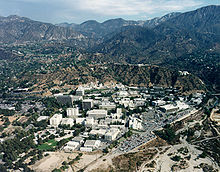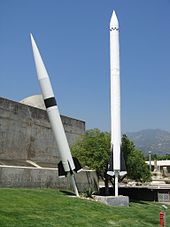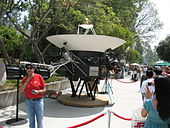- Jet Propulsion Laboratory
-
"JPL" redirects here. For other uses, see JPL (disambiguation).
Jet Propulsion Laboratory 


Aerial view of JPL in La Cañada Flintridge, California Agency overview Formed 1936 Jurisdiction U.S. federal government Headquarters Pasadena, California
34°12′6.1″N 118°10′18″W / 34.201694°N 118.17167°WEmployees > 5,000 Agency executive Charles Elachi, Director Parent agency managed for NASA by Caltech Child agency JPL Science Division Website JPL home page Jet Propulsion Laboratory (JPL) is a federally funded research and development center and NASA field center located in the San Gabriel Valley area of Los Angeles County, California, United States. The facility is headquartered in the city of Pasadena [1] on the border of La Cañada Flintridge and Pasadena. JPL is managed by the nearby California Institute of Technology (Caltech) for the National Aeronautics and Space Administration. The Laboratory's primary function is the construction and operation of robotic planetary spacecraft, though it also conducts Earth-orbit and astronomy missions. It is also responsible for operating NASA's Deep Space Network.
Among the Laboratory's current projects are the Cassini–Huygens mission to Saturn, the Mars Exploration Rovers (Spirit and Opportunity), the Mars Reconnaissance Orbiter, the Dawn mission to Ceres and Vesta, and the Spitzer Space Telescope.
JPL's Space Flight Operations Facility and Twenty-Five-Foot Space Simulator are designated National Historic Landmarks.
Contents
History
JPL traces its beginnings to 1936 in the Guggenheim Aeronautical Laboratory at the California Institute of Technology (GALCIT) when the first set of rocket experiments were carried out in the Arroyo Seco. Caltech graduate students Frank Malina, Weld Arnold, Apollo M. O. Smith, and Tsien Hsue-shen, along with Jack Parsons and Edward Forman, tested a small, alcohol fueled motor to gather data for Malina's graduate thesis. Malina's thesis advisor was aerodynamicist Theodore von Kármán, who eventually arranged for U.S. Army financial support for this "GALCIT Rocket Project" in 1939. In 1941, Malina, Parsons, Forman, Martin Summerfield, and pilot Homer Bushey demonstrated the first JATO rockets to the Army. In 1943, von Kármán, Malina, Parsons, and Forman established the Aerojet Corporation to manufacture JATO motors. The project took on the name Jet Propulsion Laboratory in November 1943 formally becoming an Army facility operated under contract by the university.[2][3][4]
During JPL's Army years, the Laboratory developed two deployed weapon systems, the MGM-5 Corporal and MGM-29 Sergeant intermediate range ballistic missiles. These missiles were the first US ballistic missiles developed at JPL.[5] It also developed a number of other weapons system prototypes, such as the Loki anti-aircraft missile system, and the forerunner of the Aerobee sounding rocket. At various times, it carried out rocket testing at the White Sands Proving Ground, Edwards Air Force Base, and Goldstone, California. A lunar lander was also developed in 1938-39 which influenced design of the Apollo Lunar Module in the 1960s.[4]
In 1954, JPL teamed up with Wernher von Braun’s rocketeers at the Army Ballistic Missile Agency’s Redstone Arsenal in Huntsville, Alabama, to propose orbiting a satellite during the International Geophysical Year. The team lost that proposal to Project Vanguard, and instead embarked on a classified project to demonstrate ablative re-entry technology using a Jupiter-C rocket. They carried out three successful sub-orbital flights in 1956 and 1957. Using a spare Jupiter-C, the two organizations then launched America’s first satellite, Explorer 1, on February 1, 1958.[6]
JPL was transferred to NASA after it was founded in October 1958, becoming the agency’s primary planetary spacecraft center. JPL engineers designed and operated Ranger and Surveyor missions to the Moon that prepared the way for Apollo. JPL also led the way in interplanetary exploration with the Mariner missions to Venus, Mars, and Mercury.[6]
JPL was early to offer employment opportunities to women mathematicians. In the 1940s and 1950s, using mechanical calculators, women in an all-female computations group performed trajectory calculations.[7][8] In 1961, JPL hired their first woman engineer to work along side male engineers as part of the Ranger and Mariner mission tracking teams.[9]
JPL has been recognized four times by the Space Foundation: with the Douglas S. Morrow Public Outreach Award, which is given annually to an individual or organization that has made significant contributions to public awareness of space programs, in 1998; and with the John L. "Jack" Swigert, Jr., Award for Space Exploration on three occasions – in 2009 (as part of NASA's Phoenix Mars Lander Team[10]), 2006 and 2005.
Location
When founded, JPL's site was a rocky flood-plain just outside the city limits of Pasadena. Almost all of the 177 acres (72 ha) of the U.S. federal government/NASA owned property that makes up the JPL campus is today located in the city of La Cañada Flintridge, California, but it maintains a Pasadena address (4800 Oak Grove Drive, Pasadena, CA 91109). The city of La Cañada Flintridge, California was incorporated in 1976, well after JPL attained international recognition with a Pasadena address. There has been periodic conflict between the two cities over the issue of which should be mentioned in the media as the home of the laboratory.
 MSL mockup compared with the Mars Exploration Rover and Sojourner rover by the Jet Propulsion Laboratory on May 12, 2008
MSL mockup compared with the Mars Exploration Rover and Sojourner rover by the Jet Propulsion Laboratory on May 12, 2008
Employees
There are approximately 5,000 full-time Caltech employees, and typically a few thousand additional contractors working on any given day. NASA also has a resident office at the facility staffed by federal managers who oversee JPL's activities and work for NASA. There are also some Caltech graduate students, college student interns and co-op students. Caltech and JPL jointly offer research opportunities for students, such as the SURF program (Summer Undergraduate Research Fellowship).
Open House
The lab has an open house once a year on a Saturday and Sunday in May, when the public is invited to tour the facilities and see live demonstrations of JPL science and technology. More limited private tours are also available throughout the year if scheduled well in advance. Thousands of schoolchildren from Southern California and elsewhere visit the lab every year.[11]
Planetary Science Summer School
The Planetary Science Summer School (PSSS) is an annual workshop sponsored by the Jet Propulsion Laboratory. The program involves an one-week team design exercise developing an early mission concept study, working with JPL's Advanced Projects Design Team ("Team X") and other concurrent engineering teams.[12]
Other works
In addition to its government work, JPL has also assisted the nearby motion picture and television industries, by advising them about scientific accuracy in their productions. Science fiction shows advised by JPL include Babylon 5 and its sequel series, Crusade.
Funding
JPL is a federally funded research and development center (FFRDC) managed and operated by Caltech under a contract from NASA. JPL-run projects include the Galileo mission to Jupiter and its moons, the Mars rovers (including the 1997 Mars Pathfinder and the twin 2003 Mars Exploration Rovers). JPL has sent unmanned missions to every planet in our Solar System. JPL has also conducted extensive mapping missions of Earth. JPL manages the worldwide Deep Space Network, with facilities in California's Mojave Desert, in Spain near Madrid, and in Australia near Canberra.
Peanuts tradition
There is a tradition at JPL to eat "good luck peanuts" before critical mission events, such as orbital insertions or landings. As the story goes, after the Ranger program had experienced failure after failure during the 1960s, the first successful Ranger mission to impact the moon occurred while a JPL staff member was eating peanuts. The staff jokingly decided that the peanuts must have been a good luck charm and the tradition persisted. [13][14]
Missions
These are some of the missions partially sponsored by JPL:[15]
- Explorer program
- Ranger program
- Surveyor program
- Mariner program
- Pioneer 3 & 4
- Viking program
- Voyager program
- Magellan probe
- Galileo probe
- Wide Field and Planetary Camera 2
- Deep Space 1 & 2
- Mars Global Surveyor
- Mars Climate Orbiter
- Cassini–Huygens
- Stardust
- Mars Odyssey
- Mars Pathfinder
- Mars Exploration Rover Mission
- Spitzer Space Telescope
- Mars Reconnaissance Orbiter
- Gravity Recovery and Climate Experiment (GRACE)
- CloudSat
- Phoenix (spacecraft)
- Ocean Surface Topography Mission (OSTM/Jason-2)
- Orbiting Carbon Observatory
- Mars Science Laboratory
- Wide-field Infrared Survey Explorer
List of directors
- Dr. Theodore von Kármán, 1938 – 1944
- Dr. Frank Malina, 1944 – 1946
- Dr. Louis Dunn, 1946 – October 1, 1954
- Dr. William Hayward Pickering, October 1, 1954 – March 31, 1976
- Dr. Bruce C. Murray, April 1, 1976 – June 30, 1982
- Dr. Lew Allen, Jr., July 22, 1982 – December 31, 1990
- Dr. Edward C. Stone, January 1, 1991 – April 30, 2001
- Dr. Charles Elachi, May 1, 2001 – Present [16]
Team X
The JPL Advanced Projects Design Team, also known as Team X, is an interdisciplinary team of engineers that "utilizes concurrent engineering methodologies to complete rapid design, analysis and evaluation of mission concept designs".[17]
Employee background check lawsuit
Main article: NASA v. NelsonOn February 25, 2005, the Homeland Security Presidential Directive 12 was approved by the Secretary of Commerce.[18] This was followed by the Federal Information Processing Standards 201 (FIPS 201), which specified how the federal government should implement personal identity verification. New specifications led to a need for rebadging to meet the updated requirements.
On August 30, 2007, a group of JPL employees filed suit in federal court against NASA, Caltech, and the Department of Commerce, claiming their Constitutional rights were being violated by new, overly invasive background investigations.[19] 97% of JPL employees were classified at the low-risk level and would be subjected to the same clearance procedures as those obtaining moderate/high risk clearance. Under HSPD12 and FIPS 201, investigators have the right to obtain any information on employees, which includes questioning acquaintances on the status of the employee's mental, emotional, and financial stability. Additionally, if employees depart JPL before the end of the two year validity of the background check, no investigation ability gets terminated; former employees can still be legally monitored.
Employees were told that if they did not sign an unlimited waiver of privacy,[20] they would be deemed to have "voluntarily resigned".[21] The rebadging rules were designed to make JPL compliant with FIPS 201. The United States Court of Appeals for the Ninth Circuit found the process violated the employees' privacy rights and has issued a preliminary injunction.[22] NASA appealed and the US Supreme Court granted certiorari on March 8, 2010. On January 19, 2011, the Supreme Court overturned the Ninth Circuit decision, ruling that the background checks did not violate any constitutional privacy right that the employees may have had.[23]
See also
- Jet Propulsion Laboratory Science Division
- Mars rovers
References
- ^ http://www.jpl.nasa.gov/about_JPL/maps.cfm
- ^ "Early Years". JPL. http://www.jpl.nasa.gov/jplhistory/early/settingstakes.php.
- ^ Clayton Koppes, "JPL and the American Space Program," (New Haven: Yale University Press, 1982); [Erik M. Conway, "From Rockets to Spacecraft: Making JPL a Place for Planetary Science," Engineering and Science, vol. 30, nr. 4, pp. 2-10]http://pr.caltech.edu/periodicals/EandS/ESarchive-frame.html.
- ^ a b Launius, Roger (2002). To Reach High Frontier, A History of U.S. Launch Vehicles. University of Kentucky. pp. 39–42. ISBN 0313122457.
- ^ Keymeulen, Didier; Myers, John; Newton, Jason; Csaszar, Ambrus; Gan, Quan; Hidalgo, Tim; Moore, Jeff; Sandoval, Steven; Xu, Jiajing; Schon, Aaron; Assad, Chris; Stoica, Adrian. "Humanoids for Lunar and Planetary Surface Operations". Pasadena, CA : Jet Propulsion Laboratory, National Aeronautics and Space Administration, 2006.. JPL TRS 1992+. http://hdl.handle.net/2014/39699. Retrieved 11 October 2011.
- ^ a b Clayton Koppes, "JPL and the American Space Program," (New Haven: Yale University Press, 1982); Erik M. Conway, "From Rockets to Spacecraft: Making JPL a Place for Planetary Science," Engineering and Science, vol. 30, nr. 4, pp. 2-10.
- ^ http://www.jpl.nasa.gov/news/features.cfm?feature=1327
- ^ http://www.redstone.army.mil/history/women_chron/1.html
- ^ FO1 D. L. Ulery and J. P. Fearey, EVALUATION OF GOLDSTONE POLAR – MOUNT ANTENNA SYSTEMA'TIC ERRORS FROM STAR TRACKS, Technical Memorandum 33-45, May 5,1962 (Unclassified)
- ^ http://www.nationalspacesymposium.org/the-phoenix-mars-lander-team-wins-2009-jack-swigert-award-for-space-exploration
- ^ "JPL Open House". http://www.jpl.nasa.gov/events/open-house.cfm. Retrieved 2 January 2009.
- ^ "Planetary Science Summer School". https://pscischool.jpl.nasa.gov/index.cfm. Retrieved 2008-05-14.
- ^ "NPR All Things Considered interview referring to peanuts tradition". http://www.npr.org/templates/story/story.php?storyId=3081033. Retrieved 2009-01-03.
- ^ "Planetary Society chat log for Phoenix referring to peanuts tradition". http://www.planetary.org/blog/ustream_log_20080525.html. Retrieved 2009-01-03.
- ^ JPL. "NASA Jet Propulsion Laboratory: Missions". Jpl.nasa.gov. http://www.jpl.nasa.gov/missions/. Retrieved 2010-08-26.
- ^ "JPL Directors". JPL. http://www.jpl.nasa.gov/jplhistory/learnmore/directors.php. Retrieved 2010-08-26.
- ^ "JPL Team X". Jplteamx.jpl.nasa.gov. 2007-08-31. http://jplteamx.jpl.nasa.gov/. Retrieved 2010-08-18.
- ^ http://www.hspd12jpl.org/what_is.html
- ^ http://hspd12jpl.org
- ^ US Office of Personnel Management. "Questionnaire for Non-Sensitive Positions" (PDF). http://hspd12jpl.org/files/sf85.pdf. Retrieved 2010-08-26.
- ^ "Declaration of Cozette Hart, JPL Human Resources Director" (PDF). October 1, 2007. http://hspd12jpl.org/files/Declaration_of_Cozette_Hart.pdf. Retrieved 2010-08-26.
- ^ "Nelson v. NASA -- Preliminary Injunction issued by the United States Court of Appeals for the Ninth Circuit" (PDF). Jan 11, 2008. http://hspd12jpl.org/files/Order_01_11_08.pdf. Retrieved 2010-08-26.
- ^ National Aeronautics and Space Administration et al. v. Nelson et al., No. 09-530 (U.S. Jan. 19, 2011).
External links
Jet Propulsion Laboratory Current missions Past missions Deep Impact · Deep Space 1 · Deep Space 2 · Explorer · Galileo · Genesis · IRAS · Magellan · Mariner · Mars Climate Orbiter · Mars Observer · Mars Pathfinder · Mars Polar Lander · NSCAT · Pioneer · Ranger · Seasat · SIR · SME · SRTM · Surveyor · SVLBI · Viking · WIREFuture missions Related organizations Caltech · NASA · Deep Space Network · Goldstone Complex · Table Mountain Observatory · Solar System Ambassadorswebsite NASA facilities NASA Headquarters
Research and test facilities: Ames Research Center · Dryden Flight Research Center · Glenn Research Center · Goddard Institute for Space Studies · Goddard Space Flight Center · Independent Verification and Validation Facility · Jet Propulsion Laboratory · Langley Research Center · Scientific Balloon Flight Facility · Stennis Space CenterConstruction and launch facilities: Johnson Space Center · Kennedy Space Center · Marshall Space Flight Center · Michoud Assembly Facility · Wallops Flight Facility · White Sands Test FacilityCalifornia Institute of Technology Research Einstein Papers Project • Infrared Processing and Analysis Center • Jet Propulsion Laboratory • Kerckhoff marine laboratory • LIGO • MonALISA • Palomar Observatory • W. M. Keck Observatory • Submillimeter Observatory • Table Mountain Observatory • Thirty Meter TelescopeStudent life Miscellaneous Categories:- Jet Propulsion Laboratory
- Government agencies established in 1930
- Space centres
- Superfund sites
- Buildings and structures in Pasadena, California
Wikimedia Foundation. 2010.



